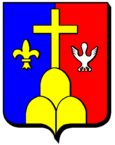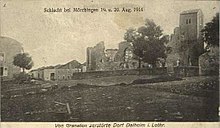Dalhain
| Dalhain | ||
|---|---|---|

|
|
|
| region | Grand Est | |
| Department | Moselle | |
| Arrondissement | Sarrebourg-Château-Salins | |
| Canton | Le Saulnois | |
| Community association | Saulnois | |
| Coordinates | 48 ° 53 ' N , 6 ° 34' E | |
| height | 218-298 m | |
| surface | 4.83 km 2 | |
| Residents | 110 (January 1, 2017) | |
| Population density | 23 inhabitants / km 2 | |
| Post Code | 57340 | |
| INSEE code | 57166 | |
 Exaltation of the Cross Church |
||
Dalhain (German Dalheim ) is a French commune with 110 inhabitants (as of January 1, 2017) in the Moselle department in the Grand Est region (until 2015 Lorraine ). It belongs to the arrondissement of Sarrebourg-Château-Salins , to the canton of Le Saulnois and to the communal association Communauté de communes du Saulnois .
geography
Dalhain is located in Saulnois , ten kilometers north of Château-Salins , 37 kilometers southeast of Metz , 35 kilometers northeast of Nancy and 26 kilometers southwest of Saint-Avold at an altitude between 218 and 298 meters above sea level between the neighboring communities of Vannecourt in the southwest and Bellange in the northeast. The municipal area covers 4.83 km².
history
Dalhain was first mentioned in 1121 as "Dalheim". The place name is a compound of the Germanic word “ Tal ” and the place name ending “ -heim ” and therefore means “Taldorf”.
Dalhain was part of the Duchy of Lorraine . The Duchy of Lorraine has been independent several times since it was founded as Lotharii Regnum by Lothar I. It later belonged temporarily to the Holy Roman Empire and also to France. In 1738 it was awarded to the Polish King Stanislaus I. Leszczyński (1677–1766) in the Peace of Vienna , which ended the War of the Polish Succession (1733–1738), and after his death in 1766 it fell to France. From 1579 Dalhain belonged to the Prévoté (Lorraine form of the bailiwick ) of Viviers . After that it belonged to the castellany of Haboudange until 1751 , which in turn belonged to the Bailliage of Vic-sur-Seille and was subordinate to the diocese of Metz . After 1751 Dalhain belonged to the newly formed Bailliage of Dieuze .
In 1793 Dalhain was given the status of a municipality in the course of the French Revolution (1789–1799) and in 1801 the right to local self-government. From 1793 to 1801 Dalhain was also the capital of a canton. From 1801 to 1871 the municipality belonged to the former Meurthe department , which was renamed the Meurthe-et-Moselle department in 1871 . In 1871 the community was incorporated into the newly created realm of Alsace-Lorraine of the German Empire due to changes in territory due to the course of the Franco-German War (1870–1871) . The realm of Alsace-Lorraine existed until the end of the First World War (1914–1918) and was then dissolved. At the time, Dalhain was in the Moselle department, this change was retained in 1918 when Moselle was again assigned to France.
During the First World War in August 1914, the place was destroyed by acts of war. On August 19, 1914, a French patrol arrived and drove out a roughly equal troop of Germans who suffered great losses. The 22nd Bavarian Infantry Regiment returned on the 20th and avenged the losses. First, French nurses and paramedics of the 20th Infantry Corps (23e section, 20e corps d'armée) and the French Red Cross (Croix-Rouge française) were rounded up and shot by the Germans. The Red Cross had set up beds in the school for the injured in the Battle of Morhange (August 19-20, 1914). In addition to the medical staff, some villagers and the local priest were also fusilized and four farms and stables were set on fire. Women and children were evacuated on August 21, 1914, while the male residents of the village (around 65) had to walk first to Morhange and the next day to Faulquemont . Then the men were taken to Zweibrücken in cattle wagons . They were charged with shooting German troops. Only a few were allowed to return to Dalhain, most were brought to Bad Kreuznach or Stettin in December 1915 and were incorporated into the German army there. The village began to be shelled on August 20, 1914. The first shells were fired at the school. The church was set on fire.
| year | 1793 | 1806 | 1821 | 1881 | 1901 | 1911 | 1921 | 1936 | 1946 | 1990 | 2007 |
|---|---|---|---|---|---|---|---|---|---|---|---|
| Residents | 348 | 451 | 591 | 410 | 302 | 286 | 231 | 186 | 171 | 108 | 114 |
Dalhain had the most inhabitants in 1821 (591), then the number of inhabitants decreased until 1990.
coat of arms
The municipality's coat of arms is divided into two parts to remind that the municipality was divided into a French and a German part. The left half is blue and shows a golden lily that corresponds to the lilies on the coat of arms of the kings of France. The right half is red and shows a silver Alérion (mutilated eagle), which corresponds to those on the coat of arms of Lorraine. In the middle there is a raised golden cross as a symbol for the patron saint Helena .
Attractions
The Dalhain ossuary was almost completely destroyed in August 1914. There remained three Romanesque arches from the 15th century, which were classified as Monument historique in 1917 .
traffic
Dalhain is on the N74 national route . The nearest airport is Metz-Nancy-Lorraine Airport , which is 15 miles northwest.
Individual evidence
- ^ Ernest Nègre: Toponymie générale de la France . tape 2 . Librairie Droz, 1996, ISBN 978-2-600-00133-5 , pp. 724 (French, in Google Books [accessed April 20, 2010]).
- ↑ Gerhard Köbler : Historical Lexicon of the German Lands: the German territories from the Middle Ages to the present . In: Beck Historical Library . 7th edition. CH Beck, Munich 2007, ISBN 978-3-406-54986-1 , p. 391 f . (French, in Google Books [accessed April 10, 2010]).
- ^ Henri Lepage: Dictionnaire topographique du département de la Meurthe . In: Société d'archéologie lorraine et du Musée historique lorrain (ed.): Dictionnaire topographique de la France . 6th edition. tape 14 , no. 18 . Imprimerie impériale, Paris 1862, p. 3 + 39 + 42 + 63 + 157 (French, in Google Books [accessed April 22, 2010]).
- ↑ a b Dalhain Notice Communale, Cassini.ehess.fr (French)
- ↑ a b Private website about Dalhain 1914 (French)
- ↑ Florent Matter: L'Alsace-Lorraine pendant la guerre. Les Alsaciens-Lorrains against l'Allemagne. Berger-Levrault, Paris 1918, p. 32 f . (French, in Gallica [accessed April 20, 2010]).
- ↑ Eyewitness account of a resident of Dalhain (French / English)
- ↑ Union des Cercles Génealogiques Lorrains (French)
- ↑ Exaltation de la sainte Croix in Nominis.cef.fr (French)
- ↑ The ossuary in the Base Mérimée des Ministère de la Culture (French)

